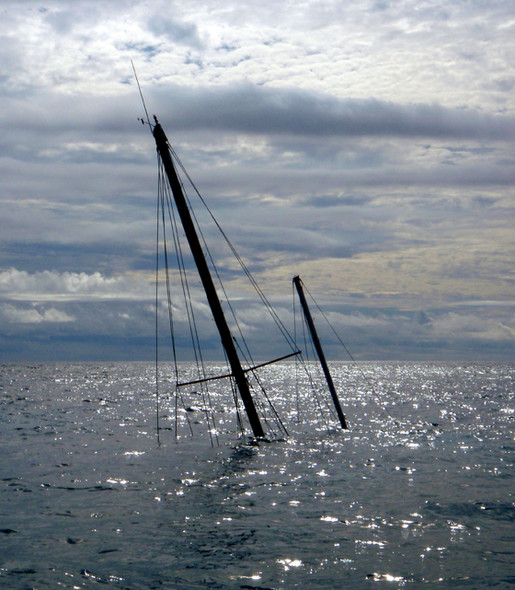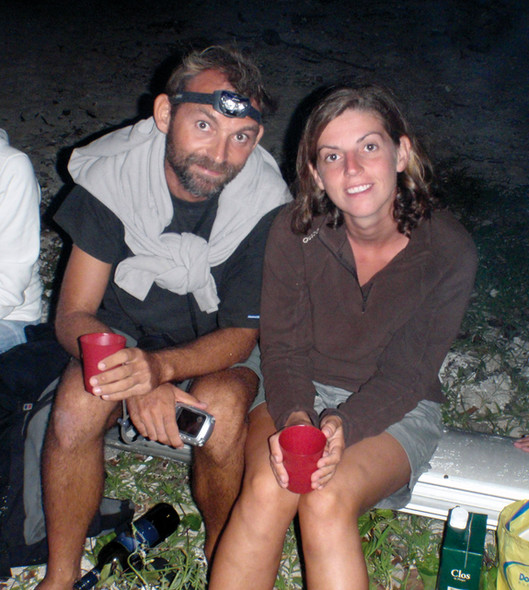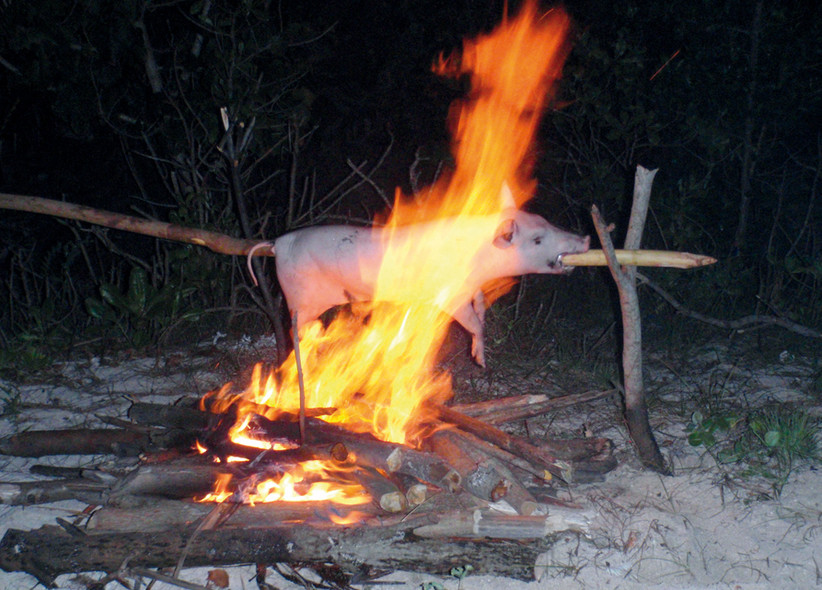
Issue #: 144
Published: November / December 2015
- Price per issue - digital : 5.40€Digital magazine
- Access to Multihulls World digital archives Digital archives
As in each edition of Multihulls World, we are following Olivier's round the world trip with his family, aboard his catamaran, Jangada. And the stopover in Tonga will inevitably remain in the crew’s memories…
Ha’apai, in Tonga. Large islands, small islands, and reefs. Hundreds of reefs... 11th October We cleared out of the Vava’u Group, filled the jerry cans with petrol, visited the fruit and veg market, then the Chinese shop, then we went to sea without delay, heading south towards Ha’apai, the archipelago situated between Vava’u in the north and Tongatapu to the south. The sailing boat La Tortue, which we had met in Niue, had just been wrecked there. As is very often the case in incidents at sea which end badly, they were victims of an unfortunate succession of technical problems which progressively worsened the situation, until it became worrying, then unpleasant, then finally disastrous. A quite classic process. We were going to the spot to see what we could do, recover some equipment at the worst, at best see if the boat could be refloated, and if not, make the wreck safe, as a minimum. The crew was already safe in Nuku’alofa, and we were in contact with them. I call Ha’apai the dangerous archipelago: it deserves the name. Probably even more so than the Tuamotus, where the approach to the atolls is often clear, steep-to. Few sailing boats venture there, at least in its most remote parts. Which in itself for me was sufficient reason to justify going to have a look... This was not without a price, as you will soon see... The Ha'apai Group is definitely not a good spot for apprentice navigators. Even experienced sailors should beware. Firstly, the place is poorly charted. Then the electronic cartography is offset, in other words wrong, by several hundred meters. The currents there are strong despite a small tidal range. And there are hundreds of reefs just below the surface of the water! It’s relatively easy to give you an idea of what the place is like: exaggerating slightly, there is not a single angular degree of the horizon where you can’t see breakers! In comparison, the Chaussée de Sein (renowned tidal race off western France) is a boulevard. In short, you must keep your eyes open, only sail during the day, and as far as possible with the sun behind you, not hesitate to climb up to the spreaders, not take your eye off the echo sounder, always be ready for an emergency maneuver and try to be safe in an anchorage before nightfall. But the most underhand danger is the squalls, especially at night... We chose the safest, exterior route, via the west of the archipelago, to get to Kelefesia, the most southerly island of the Ha’apai Group: it was here, 115 miles south of Neiafu that La Tortue was wrecked. The winds were light and unstable all night, and daybreak saw us using both engines. We passed close to the drop off of a long coral reef. It was a good place for fishing; there were lots of birds there. Suddenly the two fishing lines ran out violently at the same time. The metallic warning pawls went mad. Marin and I love this, while Adélie remains strategically neutral, through feminine solidarity. Two mahi-mahi, 1.5m long. One regained its freedom with a wonderful jump, taking everything with it. Well played, respect for the animal which this time was the stronger. The second was particularly full of fight, and was brought aboard after a lot of physical effort. I will have a few scars on my calves, as once we had hauled the animal onto the starboard sugar scoop, it fought for its life. We caught another two bonito on the same day, and the fridge was well-stocked once again. Barbara made me promise not to put the lines out again...for a long time. There and then, I had no choice but to obey. At the end of the afternoon, we slipped between the reefs and approached Kelefesia from the west. Zephyrus, which had left Vava’u the day before, was in the anchorage, and after a first dive, gave us a situation report on the subject of the wreck. We passed in silence next to La Tortue’s two masts, submerged in around ten meters of water, and carefully entered the small anchorage area, which could only hold two or three boats, and then only by keeping an eye out. The masts disappearing into the water on the horizon line were a sorry sight. We were each lost in our thoughts; someone’s story had stopped here. Like the mourning for a boat which, after having carried a family’s story going back several decades, saw the beginning of a new life project die here, in this wild, inhospitable place. How could we not imagine that a similar misfortune could happen to us too? I remember my visit to Nicolas and Marie-Laure’s boat in the anchorage at Alofi, and the drink they offered me in the cockpit... Any sailor who cruises will one day or another have a misfortune at sea. A local boat was hanging around, with local fishermen aboard who were visibly interested in the event. And what followed. But their visits to the wreck had ceased with the arrival from Nuku’Alofa of TropicBird, a powerful, over-engined inflatable kitted out for diving, which had quickly arrived on the scene after the shipwreck. With the arrival of Zephyrus, the job was handed over, and our friends Andy (a former Royal Marine Commando, but for all that, so kind and so calm) and his charming wife Rhian, had taken things in hand brilliantly. Shortly before our arrival, I had discreetly (at first, because afterwards, with the animal on the end of my line, it was harder!!!) disobeyed the head cook’s fishing ban, saying to myself that before the coming physical operations, protein in large quantities would be welcomed by the two crews already on the scene. With Marin, we caught a big wahoo nearly two meters long! We cut it in two: half for the fishermen, half for Zephyrus. That helped things run smoothly. Marin and I dived on the wreck before nightfall, to get an idea of the possibilities for refloating the boat, and sent them by e-mail to Nicolas and Marie-Laure, in Nuku’alofa. The water was completely translucent, the boat was settled on some big blocks of coral, the rudder was broken and a gaping hole, 40cm in diameter, appeared at the stern. Andy had removed the aggressive rock which had caused it. But the view of the completely intact deck, in the translucent water, was impressive. Multicolored fish had already taken possession of the wreck... The Canadian crew of Tyee! joined us before nightfall, and we all dined...on fish!!! aboard Jangada. A trend was already emerging. On the one hand, the equipment necessary for refloating the boat (inflatable parachutes in particular) wasn’t available in Nuku’alofa. It would have to be brought from New Zealand, at great expense. Considerable delivery times. On the other hand, the foreseeable costs of the overall operation (logistic support, dives, sealing the leaks, pumping out, towing, hauling out the wreck at Nuku’alofa, repair work) were excessive, with respect to the value of this elderly, uninsured ferro-cement boat. Evidently moreover (and I felt this on the telephone), after the ordeal they had just experienced, and the months they had dedicated to restoring this family boat (not forgetting the budget invested), for the moment, our friends no longer had the energy necessary to move mountains and bring their project back to life. Nicolas and Marie-Laure had given up – this was probably the wisest solution, at least financially. La Tortue would end its career here, on the reef at Kelefesia. The end of a nice story. The crew and the refitted boat had left from Papeete less than 2 months previously...
The sad sight of La Tortue’s masts, which emerged from the waters of Kelefesia (Ha'apai, Tonga)…
Once this decision had been taken, the wreck had to be made safe, which meant removing the masts and emptying the boat. Nicolas gave us the go-ahead by telephone. The next day, we started at dawn, because we had to move quickly in this precarious anchorage, where the fine weather might not last. And then Nicolas and Marie-Laure, knowing that three of their friends’ boats were on the scene, had decided to return, to spend a few hours in the place where they had been shipwrecked. To recover a few belongings, clear out everything in the wreck, discuss with Noa, the son of the island’s owner, and also say goodbye to La Tortue, and the temporary life project for which the boat had been the support. The little island ferry would bring them to Nomuka island the next morning, and from there, Noa would bring them to Klelefesia in his motor boat, where they would join us for the afternoon and the night. I liked this idea of returning to say your goodbyes to your boat. I appreciated the decision, and their courage in returning to the scene of their shipwreck.
Unfortunate cruisers, Marie-Laure and Nicolas, returned for an evening steeped in emotion, at the scene of their shipwreck…
Immediately after our anchoring maneuver, I dived to check on the chain’s trajectory and the burying of the anchor, in addition to the usual traction maneuvers with the engines in astern. During the night, what I feared most in this region of the Pacific happened: a heavy squall hit Kelefesia, and Andy, aboard Zephyrus, John on Tyee! and myself aboard Jangada, found ourselves soaked and shivering in the wind, the rain and the darkness, VHF in hand, wearing a head torch, with the engines started and deck lights on, trying to battle against the weather’s fury. A perfect trap in this kind of disreputable place. Jangada and Zephyrus found themselves next to each other in the waves, one of us had moved. We got out the fenders, I let out twenty more meters of chain, we got through it, but the warning of this very unpleasant night remained present in our memories... Later in the day, I noted that our anchor chain had cut through the several hundred kilo coral head which it had skirted at first. The chain had pulled tight, passing under the rock, which had brought us closer to Zephyrus during the night. When I think that there are some people who use ‘textile anchor warps’! At daybreak, we went to attach fenders to La Tortue’s mizzen mast, then progressively cut the all the shrouds. This allowed us to realize that the blade of the regulation cable cutters blunts very quickly: we had to finish the job with a hacksaw, lubricated with elbow grease. (Since then, I have a little electric disc cutter, aboard my new boat). We learn something every day at sea. The mast finally fell gently onto the surface of the water, then we towed it to the island’s little beach with our dinghy. It was then the turn of the main mast, which was held up by 12 cables... Harder, longer, more strenuous, but we succeeded. The spreaders caught on the coral before we reached the beach, the mast was heavy, we lost time, but the fishermen helped us: it was in a way the simplified principle of ‘No cure, no pay’, still sometimes applied in maritime rescue (before the international maritime laws were modified, after the Amoco Cadiz shipwreck on the rocks of Portsall, France in 1978...). It took us the whole morning to remove the boat’s masts and tow them to the beach. The fishermen helped with the work, looking a bit vexed, without a doubt saying to themselves that the windfall of the shipwreck was about to slip through their fingers. In fact when we discussed with them, we learned that a few decades previously, the King of Tonga had given the island of Kelefesia to Noa’s father, his friend. The island is deserted, uninhabited, inhospitable, but wonderful. There is just a makeshift camp to house the fishermen from Nomuka who stay there from time to time. During the afternoon, I noticed Noa’s boat arriving from Nomuka. I jumped into the dinghy and went to meet Nicolas and Marie-Laure. For them it was a shock. And tears of emotion. Since we had removed the masts, the only thing marking the position of the shipwreck was Jangada’s little inflatable diving raft, which I had tied to the wreck. At the moment they abandoned La Tortue, at nightfall a few days earlier, with the boat being battered on the reef and water already over the floorboards, the boat was still floating as they reached the shore in the dinghy, taking just essentials with them. They had then launched a call for help with their Iridium satellite telephone, by calling the French Coastguard (Centre Régional Opérationnel de Sécurité et de Sauvetage) at Gris Nez in France directly, which passed on the request for assistance to New Zealand and Tonga. A warship had set off early the next morning from Nuku’alofa, stopped off the island at daybreak in a sea which was still rough, and sent an inflatable to the beach to recover the four occupants of La Tortue, who had spent the night in the fishermen’s camp, around a welcome fire. When they were evacuated by the Tongan warship in the early morning, La Tortue’s crew noticed that the boat had of course settled during the night, but was still afloat. At the moment when the victims rediscovered the site calmly, the wreck was resting on the coral, around 10 meters below the surface. A small trickle of diesel made the surface iridescent, as it escaped slowly from the fuel tank. Marie-Laure found it hard to control her tears; Nicolas was silent. As for us, we didn’t talk much. The dinner was welcome. Andy had succeeded in getting a few bottles of wine out of the wreck, which did everyone a lot of good. We almost managed to make our shipwreck victims smile. Nicolas and Marie-Laure asked us to leave them for 20 minutes so they could dive on the wreck alone; I took them in the dinghy to a spot vertically above it, and we left them alone, facing the adversity and the reality of what their boat had become. Then work on the wreck started again, and everything it contained was brought out during the afternoon. Equipment which could be sold went aboard Zephyrus and Tyree!, which were then heading to Nuku’alofa. Whilst Jangada had to sail north, towards the island of Nomuka, to drop off Noa’s wife, who, as the only person to speak a few words of English, had come for the day with her husband and daughter Cristina, to try and negotiate the transfer of ownership of the wreck (it was finally given to the government of Tonga). Everything which couldn’t be sold went in Noa’s boat. During the evening, when we had all returned aboard and the sun was sinking in the west, Nicolas and Marie-Laure moved into Jangada’s starboard cabin. From the beach a few tens of meters away, Noa signed to me to join him. He made me understand through sign language that everyone was invited that evening to a barbecue, and that two pigs had been slaughtered for the occasion. I spread the good news from the dinghy, and we all met up a bit later on the little beach, where Noa’s Tongan friends had lit a big fire, on which they were cooking two plump piglets, on wooden spits. A nice way of turning the page for La Tortue’s crew, who the next day, would be returning to Nuku’alofa. And then a few days later, to France, to start another life. Nicolas, who was in no way obliged to, kindly gave the children his kites, which had been rescued from the wreck. He dropped off a bag of shackles and snap shackles, a jerry can of diesel, a coat on the deck. An elegant gesture, but we weren’t there for that. The next morning, Nicolas and Marie-Laure embarked aboard Tyee!, which took them to Nuku’alofa; Zephyrus remained, to finish cleaning up the wreck with the islanders, and we set a course for Nomuka, a dozen miles to the north-west, to drop off Maria and her daughter. Most of the very few boats who in the future visit the anchorage at Kelefesia will doubtless be unaware that there, under the water, amongst the rocks, just 200 meters from the little beach, lies the wreck of La Tortue. Nothing indicates it on the surface of the water. Just our memories. But for Jangada and its crew, the adventure in the Ha’apai continued...
The fishermen from Nomuka, who came to Kelefesia, socialized with the three assisting crews...



What readers think
Post a comment
No comments to show.